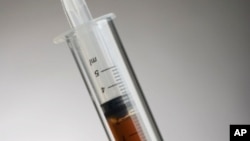Researchers have developed a synthetic blood additive that can help stop the massive and potentially fatal bleeding often caused by battlefield wounds and car accidents.
Experts say traumatic injury is the leading cause of death in people between the ages of four and 44. They say bleeding from such injuries often overwhelms the body's ability to form clots to stop the bleeding and begin the healing process.
Erin Lavik, a professor at Case Western Reserve University in Ohio, says the only way to treat such injuries is through compression - applying pressure to a wound until it stops bleeding.
"So, if you have injuries that can't be compressed or aren't exposed, it's very hard to staunch the bleeding in the field," said Erin Lavik. "And so we developed this system to try to deal with those cases; the cases where you have complex internal injuries, the cases where you want to stop the bleeding."
Inspired by U.S.soldiers who have sustained life-threatening wounds in Iraq and Afghanistan, Lavik and colleagues developed synthetic molecules that mimic the action of blood platelets - the minute, colorless particles in the blood that promote clotting and staunch bleeding by adhering to other platelets.
When there's an injury, Lavik says, blood platelets become activated at the wound site. They mesh together with other platelets to form a plug mixed with fibrous protein to stop bleeding and heal damaged blood vessels.
Unfortunately in traumatic injuries, Lavik points out the activity of platelets can become overwhelmed by massive bleeding.
The synthetic particles developed by Lavik and her colleagues promise to enhance blood clotting in these instances.
"Essentially, they augment the system by binding with the activated platelets and helping them form the plug," he said.
The artificial platelets developed by researchers are made from biodegradable chemical molecules called polymers. Lavik says the man-made particles home in on an injury site and combine with natural platelets to form a plug.
In a study, the artificial platelets injected into rats prior to injury staunched bleeding in half the time it took for bleeding to stop in untreated animals. In rats treated with the artificial polymers twenty seconds after injury, clotting occurred twenty-three percent faster than in untreated rats.
Lavik says more work is needed before the artificial platelets could be used in humans, but she thinks they show real promise.
"The medic in the civilian or in the military case gets to the field and can look at someone and say 'it looks like they've had multiple traumas," said Lavik. "We can administer this.' And if we want that to be possible, we've got to make sure it's exceptionally safe and simple and room temperature stable."
An article describing the artificial blood platelets is published in the journal Science Translational Medicine.
News
Researchers Develop Artificial Clotting Agent to Help Stop Massive Bleeding




